Harriers in battle: Falkland conflict 1982 g (part of 8)
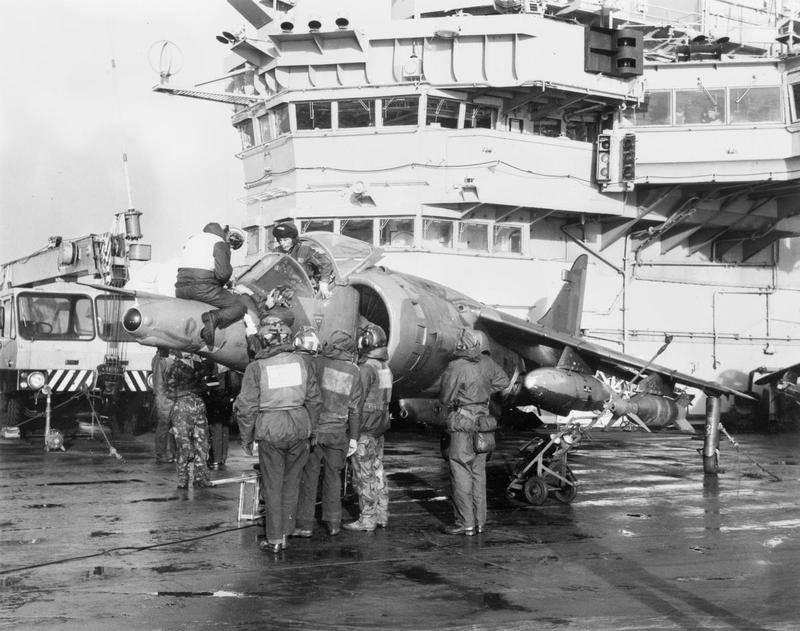
So, dear readers, in front of you is the last article of the cycle. It's time to draw conclusions.
Conclusion 1 - Argentines could not realize the superiority in the number of combat aircraft, in fact, the British were confronted in the air with approximately equal forces.
I draw the attention of dear readers: the statistics were not taken for the entire period of the Falkland conflict, but only from the beginning of large-scale hostilities to the end of the fighting on the "bomb alley" - the British called the section of the Falkland Strait in the area of the Bay of San Carlos, where May 21-25 the most fierce aerial battles for the entire campaign. The reason for this sample is that until May 1 there are some significant military operations with aviation was not conducted, but it was precisely on May 25 that the air war for the Falkland Islands was lost by the Argentines. Beginning May 26, the command of Argentina abandons the basic idea of island defense - to prevent an English landing by inflicting an unacceptable level of English losses naval grouping and switches its aircraft to work on coastal targets. Moreover, its actions after May 25 were of an irregular, sporadic nature - if in 5 days of fighting on the "bomb alley" Argentine strike aircraft made 163 sorties, then for the entire period from May 26 to June 13 (19 days) - no more than a hundred.
It should also be borne in mind that the column of Argentine aviation sorties reflects only the actions of Argentine fighter and attack aircraft (in brackets - minus air sorties of light attack aircraft of the Squadron Pukara Malvinas). Departures "Mirages", "Daggerov" and "Skyhawks", which, in fact, posed a danger to British ships and aircraft, fully accounted for. Also fully accounted for known cases of search and / or attacks by the British forces of light aviation. But part of the aircraft light aircraft in the above statistics did not get - for example, it is known that 2 May Argentines raised the aircraft of the Falkland Islands to inspect the potential landing of the British. But what, how much and where it is unclear, therefore it is not possible to take into account such air travel. Also, the indicated column does not include reconnaissance aviation flights, tankers, PLO aircraft off the coast of Argentina, etc.
Therefore, the number of sorties shown in the "Argentine" column of the table above can be interpreted as this is the number of aircraft of fighter and attack aircraft undertaken to provide air defense of the Falkland Islands and attack British ships. In a similar “British” column, the number of sorties of only vertical take-off and landing aircraft is indicated — flights of Nimrod, Volcanoes, tankers and other UK aircraft are not included in it.
What immediately catches the eye? The Argentines, concentrating against the English no less than 75-85 "Skyhawks", "Daggers", "Mirage" and "Canberra" (this is already minus the technically faulty and "reserved" in case of a Chilean invasion of machines) and received from repairmen some more " Skyhocks ”during the conflict, could theoretically make daily 115-160 sorties of combat aircraft alone (1,5-2 departures on an 1 machine). But in practice, the maximum reached was 58 sorties (May 21). In total, for the 25 days of the hostilities that determined the military loss of Argentina, its aircraft more or less intensively used the 8 days during which the 244 was flown, ie even during these 8 days, on average, only 31 was flown a day. During the culmination of the struggle in the air - five days of fighting over the “bomb avenue”, the average number of sorties was 32,6 per day.
The British, having a much smaller number of aircraft, flew much more often. Unfortunately, in the literature available to the author there are no complete data on the sorties of the British VTOL, but Rear Admiral Woodworth in his memoirs indicates that May 22:
At the same time, D. Tatarkov indicates that the 23 of May 317s of the operational connection made 58 airplanes, of which 29 - to cover the bay of San Carlos. It turns out that the British for the three days of the battle on the "bomb avenue" made more sorties than the Argentines for all five. At the same time, such data correspond very well to the size of the British air group - on 21 May, there was an 31 aircraft on the decks of British aircraft carriers, which, given technical readiness over 80% (as they are written by A. Zabolotny and A. Kotlobovsky), just gives about 2 departure in day on one plane. On the other hand, it is completely unclear whether the “Harriers” of GR.3 were involved in air patrols. If not, then it turns out that the British 25 "X Harriers" (of which the 21-23 machines were combat-ready at any one time) carried out up to 60 sorties a day, i.e. almost 3 departure for one aircraft.
Of course, this was the peak load that the British could hardly withstand continuously - according to A. Zabolotny and A. Kotlobovsky, the British VTOLT made 1650 sorties in the combat zone. Even if you do not take into account flights made before 1 in May, ignore the fact that the planes flew even after the end of hostilities, and assume that all 1650 sorties were made between June 1 and June 13 (44 of the day), is still the average The number of sorties will not exceed 37,5 departures per day. Given that in some cases (such as battles on the “bomb lane”), the British flew more often, respectively, on “quiet” days - less often.
Probably it would not be a mistake to assume that on normal days the number of sorties by the British air group did not exceed 30-35, but during intense fighting the number of sorties could reach 60 per day, of which about half fell on the defense of the landing area and the second half was cover aircraft carrier group. It is worth noting that 2-3 air travel per day for one car is a great answer to anyone who believes that deck aircraft cannot operate with the same intensity as ground-based aircraft. During the “Storm in the Desert”, MNF aircraft made an average of 2 sorties per day. It should also be noted that if the Argentines were able to provide their aircraft with a level of combat capability comparable to the English (technical readiness ratio 0,85 and 2-3 departures per day), then Argentine aviation would carry out every day from 130 to 200 sorties. Obviously, the British air defense could not withstand such tension, and the British amphibious group would be defeated within 1-2 days.
But another thing is also interesting - provided that 2-3 carried out sorties per day per vehicle, the number of actually completed Argentine sorties could have been provided by an air group that consisted of approximately 38-40 combat aircraft at the beginning of hostilities - and this taking into account the losses they actually suffered ( i.e., by 21, the aircraft would have remained on the order of 30-32, etc.). Therefore, it is surprising, but it can be said that the British in the Falklands faced a roughly equal in number air enemy.
However, while paying tribute to the work of British pilots and technicians, we must not forget that the 25-30 aircraft departures a day to cover the disembarkation zone are 12-15 pairs of Sea Harriers during the day. Given the fact that the British aircraft carriers were located not less than 80 miles from the islands, it is unlikely that one pair could patrol for at least an hour. Which in turn means that the British aircraft carrier 2 were able to ensure constant airborne duty over their amphibious group of just one pair of Sea Harriers (sometimes increasing the patrol to two pairs).
Conclusion 2: Despite the comparable balance of forces in the air, the air defense task of the naval connections was a British carrier-based aircraft completely failed.
Over the entire period of May 1-25, Argentines 32 once tried to attack British ships, in which 104 aircraft took part. The British managed to intercept groups of attacking 9 aircraft once (before they launched an attack), but only 6 attacks (19% of the total) managed to thwart; All in all, from 104, the attacking aircraft 85 was able to attack British ships, i.e. "Sea Harriers" were able to thwart the attacks of all 18,26% of the total number of Argentine aircraft participating in them.
On the other hand, it should be borne in mind that the two attacks that took place on 12 in May, in which eight Skyhocks took part, were deliberately missed by the British: Rear Admiral Woodworth was trying to figure out how strong the air defense could provide a combination of Sea Dart air defense system and "Sea Wolfe", substituting for the Argentines the destroyer "Glasgow" and the frigate "Brilliant". Therefore, to put these attacks in the reproach of "Sea Harriers" is not entirely correct. But, even having excluded these attacks, we find out that “Sea Harriers” were able to prevent 20% attacks, and 19,8% of the total number of aircraft that took part in them did not reach the British ships. For the “battle on the bomb lane,” this figure is even more modest - 26 (22%) are successful from 84,6 attacks, from 85 aircraft that participated in the attacks broke through to the 72 ships (84,7%).
Conclusion 3: Fighter aircraft alone (without external target designation) can neither achieve air supremacy, nor provide any reliable air defense of sea or land connections.
All in all, from 1 to 25 in May, there were 10 cases when “Sea Harriers” intercepted Argentinian planes before the last attack. In this case, nine cases of interception of strike aircraft were carried out according to external target designation, which was given by British warships. The only case where the C Harrier pilots were able to independently detect the target was the interception of the 1 “Mentor” link in May, but even this is not clear. it is not excluded that the Harriers launched the Sea King helicopter, which the Argentines were about to attack. On the same day, Sea Harriers became targets of Argentine fighter aircraft three times, and in at least two of the three Argentines, they were guided by the ground flight support service of the Falkland Islands.
4 output (which is perhaps the enhanced version of 3 output): The main reason for the ineffectiveness of the British carrier-based aviation in their air operations was the separate use of strike and fighter aviation without ensuring its operations by reconnaissance aircraft, airborne early warning systems, RTR, EW
The effectiveness of modern air war directly depends on the competent use of all the “combat arms” of aviation. Then a synergistic effect begins to operate, which clearly showed the complete helplessness of the British against the joint actions of the Super Etandars, the reconnaissance Neptune and the Argentinean tankers 4 in May, when the Sheffield was heavily damaged by a missile attack. The British had significantly larger forces, their carrier-based aircraft were supported by a very powerful naval defense, and the Sea Harriers were individually stronger than any Argentine aircraft. But none of this helped them. The same goes for the effectiveness of the Harriers when working on ground targets.
5 Conclusion: The main reason for the “off-system” use of the Harriers was the concept of aircraft-carrying vehicles of the VTOL aircraft, on which the DRLO, RTR and EW planes simply could not be based due to the lack of an ejection takeoff.
Thus, the Harrier fiasco at Falkland is not due to the fact that these aircraft are VTOL, but with the absence of aircraft in the aviation groups that support and support the actions of fighter and attack aircraft.
5 Conclusion: The merits inherent (or attributed) to VTOL aircraft did not affect the course of the hostilities.
A. Zabolotny and B. Kotlobovsky in the article “Falkland Harriers” write:
Over the Falklands took place the entire 3 battle between fighters (all - May 1). In the first case (2 "Mirage" against 2 "Sea Harriors"), neither side was successful. Judging by the available descriptions, the Argentines attacked the British, they noticed the "Mirages" and turned towards them, after which the Argentines used missiles from the distance of the order of 20-25 km and left the battlefield. In the second case, the pair of “Mirage” tried to get close to the British on a head-on course, after which, skipping over the “Sea Harerami”, make a sharp reversal, and go to the tail of the British. The descriptions of what happened later differ, the most similar to the agile battle looks like this - the Argentines and the British, moving on converging courses, flew past each other, while the pilots of the Mirage lost the British mind. Then "Sea Harriers" turned around, went to the tail of the "Mirage" that did not see them and shot them down. In the third case, the Dagger of Ardiles was able to quietly attack the pair of Sea Harriers, his missile did not hit the target, and at high speed he jumped past the relatively slow-moving British air patrol (usually Sea Harriers patrolled at a speed not exceeding 500 km / h) and tried to leave, taking advantage of the superiority in speed - but "Sidewinder" was faster. In all other cases, "Sea Harriers" shot down attack aircraft, which tried to break through to the British ships, or, dropping bombs, tried to escape from "Sea Harriers". Consequently, if Sea Harriers had superior maneuverability, they could not realize it due to the lack of maneuvering battles.
However, in the above-mentioned article there is such a description:
The only battle that fits this description is the destruction by the British patrol of one of two Dagger triples trying to attack the British ships at San Carlos. However, this episode in the description of A. Zabolotny and B. Kotlobovsky looks extremely doubtful. First of all, it is known that the second three of the Daggerov nevertheless entered the British ships (the Diamond frigate was attacked by it). Secondly, the Daggers of Argentina were equipped with either free-fall bombs or air-to-air missiles, but not both at the same time. And, thirdly, the British themselves describe this fight much more modest. Thus, Rear Admiral Woodworth writes in his memoirs:
That is, apparently, there was a detection and destruction of the three attack aircraft without a “dog dump” and a rocket fire.
6 Conclusion: The main factor behind the success of Sea Harriers in aerial combat was their use of the AIM-9L Sidewinder missiles.
This rocket gave the British a huge advantage, but not only because it allowed them to hit enemy aircraft in the forward hemisphere. The fact is that the effectiveness of these missiles was of the order of 80%, which practically guaranteed the defeat of the target when approaching it to the launch distance. Interestingly, the effectiveness of the "Sidewinder" was about twice as high as that of the C-Wolfe air defense system.
Rear Admiral Woodworth believed that the Argentines made a serious mistake by not trying to cover up the attacks of their strike aircraft with fighter aircraft. But in such tactics there was a reason: sending several groups of strike planes to the battle, the Argentines could well expect that at most one link would be intercepted, and even then not every time - which, by the way, constantly happened in practice. However, even if the link would be intercepted by the British, the pilots had good chances to run, using the low speed VTOL. But the pilots of the Mirage with their Shafriras, who were thrown into battle against the Sea Harriers with their all-rocket missiles, had a zero chance of survival. Accordingly, it was much more effective to send the Dagger link to attack the ships, allowing the pilots to flee in the event of interception, rather than equip this link with air-to-air missiles and almost guaranteed to lose it in a battle with Sea Harriers.
On the other hand, if the Argentines had at their disposal all-round missiles of similar quality, then the outcome of the air battles could have significantly shifted against the British.
Conclusion 7: The disadvantages of "Sea Harier" inherent to them as VTOL, markedly reduced their effectiveness.
The main disadvantages of "Sea Harriers" were:
1) Low speed, which very often did not allow them to catch up with the Argentine planes fleeing from them, as a result of which the list of downed "Sidewinders", "Daggers", "Skyhawks" and so on. much shorter than it could be. For example, if the British had Phantoms, it would be unlikely that at least one of the six Canberras, so imprudently sent to search for British ships on May 1, would have survived. VTOL aircraft managed to shoot down only one aircraft of this type
2) Insufficient combat radius, as a result of which one (rarely two) pairs of Sea Harriers could be on duty over the landing site. The same "Phantoms" could "patronize" the amphibious formation much more tightly.
3) Small ammunition load - 2 "Sidewinders", which is at least half as much as a horizontal take-off and landing fighter could carry. As a result, after intercepting the enemy flight, the British were forced to return in any case, even if there was enough fuel for further patrols - you won’t get much without missiles.
However, it should be noted that the absence of these shortcomings (i.e. if suddenly the C Harriers acquired magically the speed, ammunition and combat radius they needed) would somewhat improve the combat statistics of the British carrier-based aircraft, but would not dramatically improve their performance.
Conclusion 8: Despite all the above, it should be recognized that "Sea Harriers" were the best means of air defense of all that were available to the British.
Amazing isn't it? After so many swear words addressed to the VTOL aircraft, the author is forced to recognize them as the best ... but this is true. However, it should be understood that “Sea Harriers” became the leaders of the British air defense not because they were good in this role, but because the other air defense weapons turned out to be even worse.
From the table above, we see that in the period from 1 to 25 in May, the “Sea Harriers” shot down the enemy's 18 aircraft, and for the most part these were “Mirage”, “Skyhawk” and “Dagger”. The author didn’t count a “Sea Harrier” one “Mirage”, which was hit by 1 in May - the plane was damaged, but still had chances of an emergency landing. This plane is reflected in the column "Argentine anti-aircraft gunners," because it was they who killed him. As for the 3 aircraft destroyed on the ground, then we are talking about light attack aircraft, exterminated during the raids on the airfields of Gus Green and Stanley. In this case, the minimum figure was taken, it is possible that the "Harriers" destroyed, or brought to the end of the war during the raids on the airfields, more cars.
Accordingly, the share of VTOL aircraft can be recorded 21 destroyed aircraft, or almost 48% of their total number, killed 1-25 in May. The next best performers are SAS fighters with their 11 aircraft destroyed during a raid on Fr. Pebble These are 25% of the total, but still the success is leveled by the fact that the 5 aircraft were only light attack aircraft, and the rest of the six were completely stupid Mentors. The air defense missile system and the artillery of the ships are in third place, seven vehicles (19%). Of interest is the fact that for the Argentine aviation, their own anti-aircraft gunners were just as serious a danger as the British ones - both of them shot down Argentinian 2 aircraft. But here it is necessary to take into account discrepancies about the Skyhawk's downed 25 in May - the British believe that this plane hit the C Cat missile system from the Yarmouth frigate, while the Argentines are sure that it was the ground Rapier. The author credited this victory to Yarmouth, because the British probably had more opportunities to identify the deadly attack on the air defense system. And finally, the other losses are the Skyhawk, which, making an antimissile maneuver, fell into the sea during the attack of the frigate Brilliant 12 in May. In this attack, Xi Wolfe launched an 2 aircraft rocket launcher and it is extremely doubtful that a third rocket was fired, so with the 99.9% probability no one fired at the Skyhawk — the pilot reacted too nervously to the launch of the missiles that were not intended for him.
In the year 1982, the British sent a quick link to the Falkland Islands, which was clearly weak and unable to carry out modern sea and air operations. Fortunately for the British, the Argentine armed forces turned out to be a “paper tiger”. Without challenging the courage, heroism and martial art of individual warriors of this nation, we have to admit that the Argentine Air Forces turned out to be completely unprepared for a modern war, and in a terrible technical condition. At least 70-80 combat aircraft at the peak of combat readiness are not able to make 60 aircraft sorties a day, and, having lost a dozen aircraft, they "moved out" to 20-25 aircraft sorties - one flight on an 3 aircraft per day! But even from those cars that were able to lift into the air, sometimes up to a third of the cars came back for technical reasons.
But even the few Argentine links, attacking without any tactical design, without preliminary reconnaissance of targets, without clearing the airspace, without suppressing the air defense of ships, and even using non-explosive free-falling bombs, almost put the British fleet on the brink of defeat. Weak attacks by Argentines met with no less weak British air defenses, with the result that each side suffered sensitive losses, but still could inflict equally significant losses to the enemy. If the British had a full-fledged carrier group with a catapult aircraft carrier - the Argentine Air Force simply broke up on its air shield, so that the war would have ended without starting. If the Argentines had, instead of their 240, “military aircraft”, a modern air group of about fifty vehicles, including RTR, DRLO and EW planes, strike aircraft, and fighters equipped with modern guided weapons and equipment, and pilots capable of properly exploiting all this - the British The 317 connection would not last two days. But each side had exactly what it had, so the question was only who could bear the loss longer. The British were stronger - and won the conflict. Affected training, character and, of course, regularly suitable reinforcements. In the war of attrition, the Sea Harriers became the weapon system that was able to inflict the most casualties on the Argentines and played a key role in the Falklands conflict.
However, in the future there was a substitution of concepts. Just as the death of General Belgrano disguised the failure of the British operation to establish naval and air supremacy in the Falkland Islands 1-2 in May, so also underscore the exceptional role of Sea Harriers in the Falklands (which is to a certain extent true) retouched the inability of aircraft carrier ships of VTOL aircraft to support air defense formations and conduct effective air strike operations. Moreover, as has been repeatedly noted, the reason lies not in the tactical and technical characteristics of the VTOL aircraft, but in the absence of airborne early warning aircraft, RTR, EW aircraft and so on as part of the air group.
Interestingly, a similar situation exists with nuclear submarines, whose successes in the Falkland conflict were more than modest. Of course, Concaurus, aimed at the US satellite intelligence target, was not difficult to destroy the antediluvian General Belgrano. But later the submarines could not find the Argentine fleet during its movement to the Falklands, and when the APA ships pulled back to their native coast and the British submarines followed them, then ... the super modern ships were squeezed out of the coastal waters of Argentina within a matter of days.
History The Falkland conflict once again teaches us that no, even a very perfect weapon can replace and is unable to resist the systematic use of disparate forces.
At this, dear readers, I finish the series of articles "Harriers in battle: the Falklands conflict 1982." But on the topic of the Falkland conflict will be posted another, “non-cyclical” article with an alternative historical bias, in which the author will try to answer the questions: “Was it possible to replace British aircraft with newer air defense systems?”; “Could the British scrape funds for the ejection aircraft carriers, and what could the replacement of aircraft carriers carrier for VTOL aircraft have provided for the ejection aircraft carrier?”, “What would happen if the British sent the modernized battleship Vangard to the rescue? In any case, it is not necessary to simulate the results of armed clashes, based on the passport specifications of military equipment.
Thank you for attention!
PS During the discussion of the articles, many distinguished commentators have repeatedly expressed the idea of some similarity of the Falkland conflict with a cozy medical institution, where the wards are soft, the orderlies are extremely polite and the injections do not hurt at all. Within the framework of this theory, I would like to note:
The gallant British BBC has at least three major countermeasures to the British military. The first time happened when they the news trumpeted that Task Force 317 of Rear Admiral Woodworth had joined the amphibious group. It was impossible to more accurately inform the Argentines about the impending landing. For the second time, following the results of the first battles “on the bomb alley”, journalists announced to the whole world that Argentine bombs did not explode. Apparently so that the Argentine services correct this misunderstanding as soon as possible. And finally, the third case - when the news reported about the impending assault on Darivin and Gus Green by British paratroopers, as a result of which the Argentines were able not only to prepare the forces they had there for the assault, but also to transfer substantial reinforcements to the defenders. Argentine admirals and generals after the war admitted that 90% of all intelligence information was kindly provided to them by the British press.
And further. Perhaps Rear Admiral Woodworth was not Nelson, but he still succeeded in an extremely complex operation, which for England was the return of the Falkland Islands. How did the Fatherland meet him?
From the memoirs of the admiral:
... we have revised your representative money content accordingly, downwards by pounds per day for 1,78. Moreover, we recalculated this amendment from the date of your appointment in July 1981. It has been established that you have overpaid 649,70 pounds.
We would like to receive this amount in full and as soon as possible.
References
1. D.Tatarkov Conflict in the South Atlantic: Falklands War 1982
2. Woodworth S. Falklands War
3. V. Khromov Ships of the Falklands War. Fleets of Great Britain and Argentina // Marine Collection. 2007. №2
4. V.D. Dotsenko Fleets in local conflicts of the second half of the XNUMXth century.
5. A. Kotlobovsky The use of A-4 Skyhawk attack aircraft
6. A. Kotlobovsky The use of Mirage III and Dagger aircraft
7. A. Kotlobovsky Not by number, but by skill
8. A. Kotlobovsky A. Zabolotny The use of attack aircraft IA-58 "Pucara"
9. A. Zabolotny, A. Kotlobovsky Harriers in the Falklands
10. A. Kotlobovsky, S. Poletaev, S. Moroz Super Etandar in the Falkland War
11. S. Moroz Super Etandar in the Argentine Navy
12. Y. Malishenko Combat debut of a veteran (Vulcan)
13. N.N. Okolelov, S.E. Shumilin, A.A. Chechin Aircraft carriers of the “Invincible” type. 2006. No. 9
14. Mikhail Zhirokhov Falklands 1982 Win Data
15. BATTLE ATLAS of the FALKLANDS WAR 1982 by Land, Sea and Air by Gordon Smith
- Andrei from Chelyabinsk
- "Harriers" in battle: Falkland conflict 1982 g (part of 1)
"Harriers" in battle: Falkland conflict 1982 g (part of 2)
"Harriers" in battle: Falkland conflict 1982 g (part of 3)
"Harriers" in battle: Falkland conflict 1982 g (part of 4)
"Harriers" in battle: Falkland conflict 1982 g (part of 5)
“Harriers” in battle: Falklands conflict 1982 (part of 6)
“Harriers” in battle: Falklands conflict 1982 (part of 7)
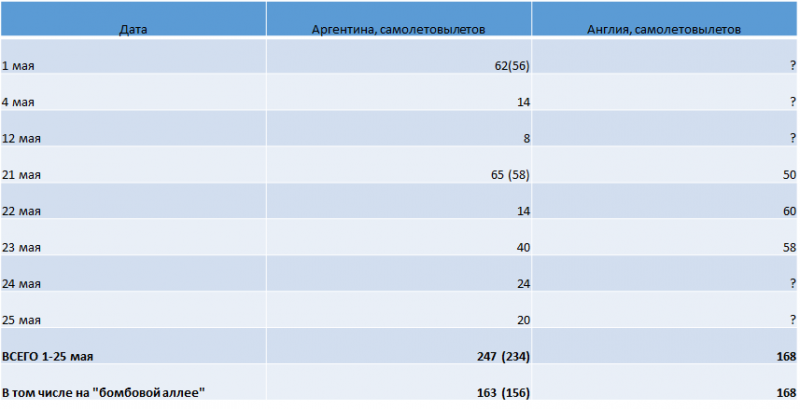
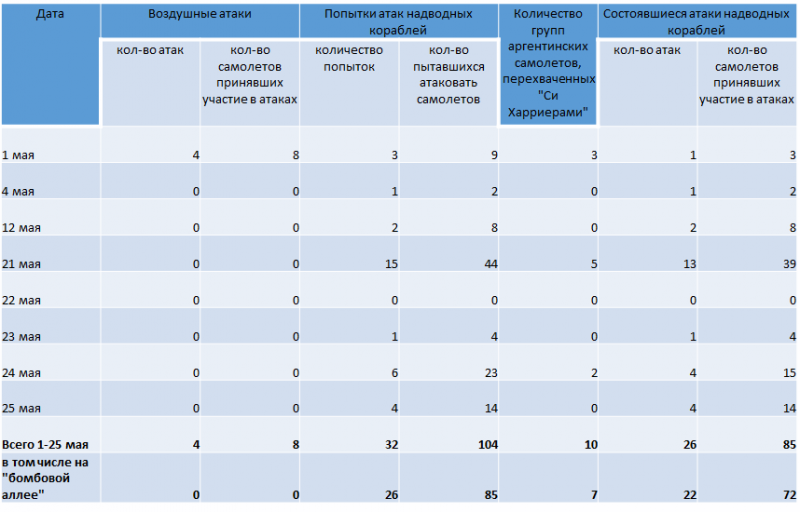
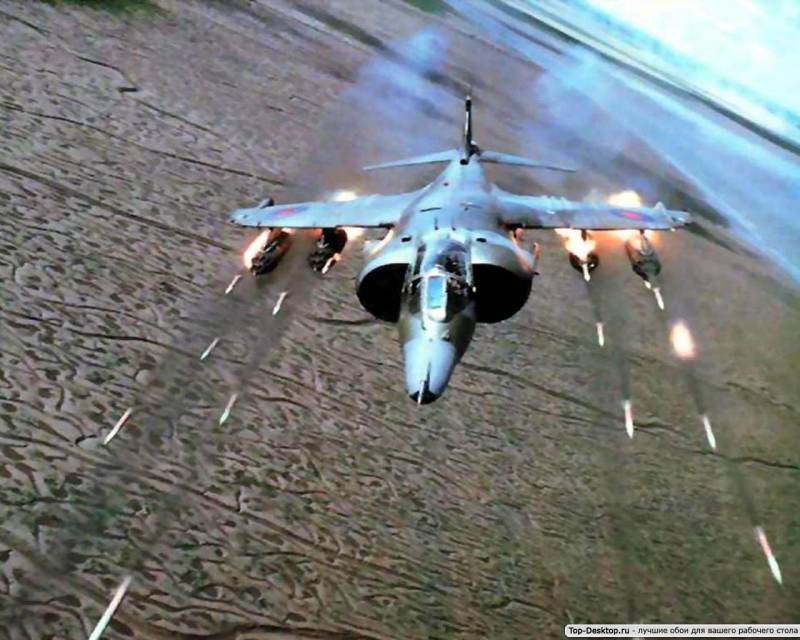
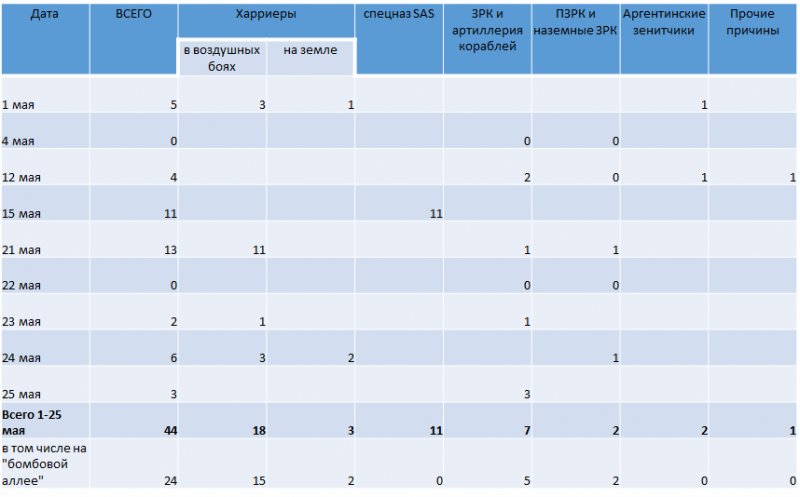
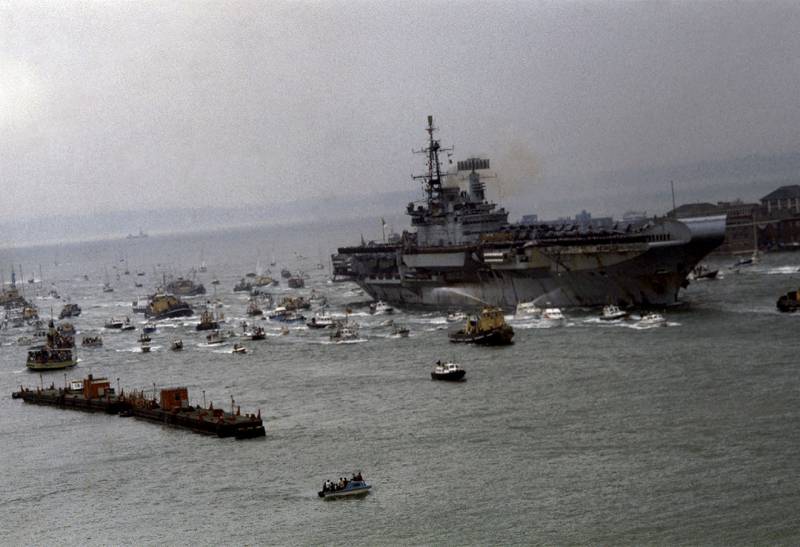
Information